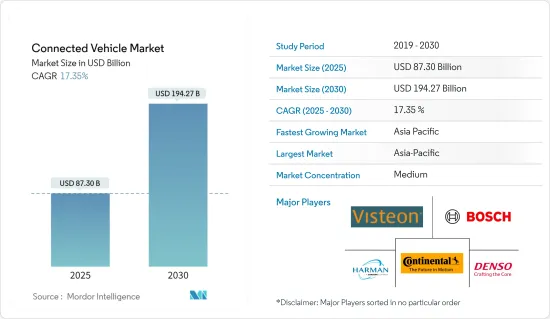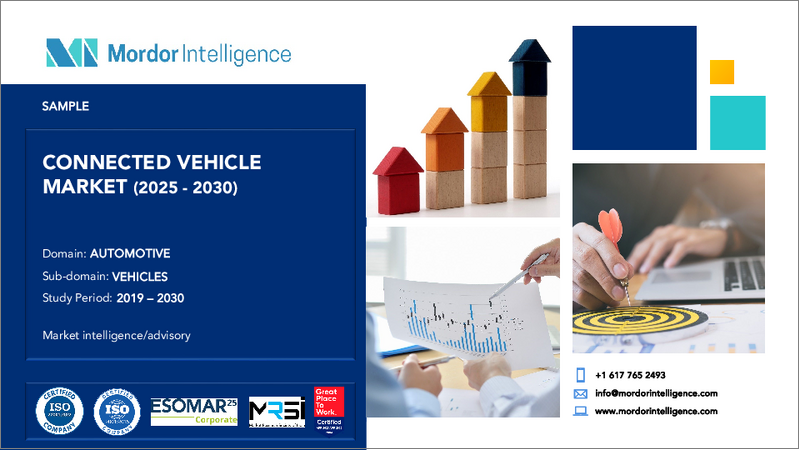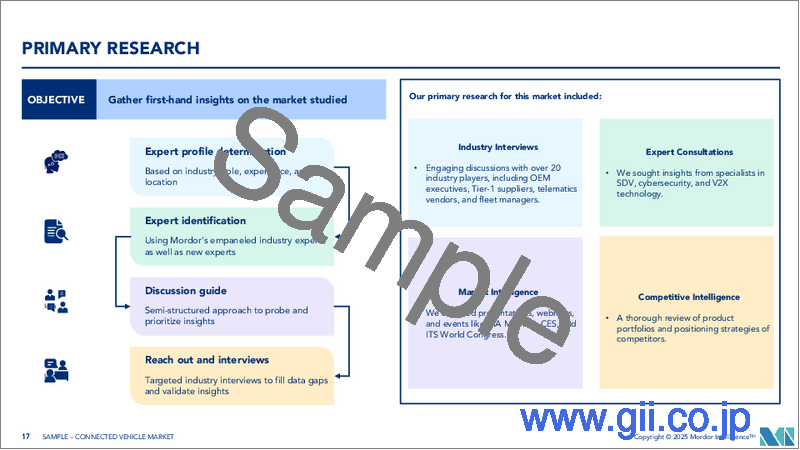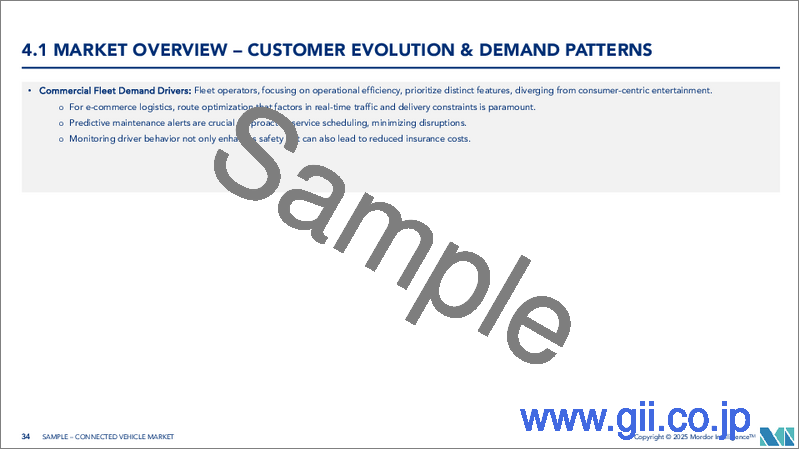|
|
市場調査レポート
商品コード
1689869
コネクテッドカー- 市場シェア分析、産業動向・統計、成長予測(2025年~2030年)Connected Vehicle - Market Share Analysis, Industry Trends & Statistics, Growth Forecasts (2025 - 2030) |
||||||
カスタマイズ可能
適宜更新あり
|
|||||||
| コネクテッドカー- 市場シェア分析、産業動向・統計、成長予測(2025年~2030年) |
|
出版日: 2025年03月18日
発行: Mordor Intelligence
ページ情報: 英文 80 Pages
納期: 2~3営業日
|
全表示
- 概要
- 目次
コネクテッドカー市場規模は2025年に873億米ドルと推定され、予測期間(2025年~2030年)のCAGRは17.35%で、2030年には1,942億7,000万米ドルに達すると予測されます。

COVID-19のパンデミックは、ロックダウンや貿易制限によってサプライチェーンが混乱し、世界中で自動車生産が停止したため、調査対象の市場に大きな影響を与えました。しかし、規制が緩和されるにつれて、企業は予測期間中に市場に勢いを生み出すために、そのようなリスクと開発を軽減することに集中し始めました。
ADAS(先進運転支援システム)、車両インフォテインメントなど、先進的な安全・快適機能の車両への統合が進み、市場が大きく成長しています。乗員の快適性と安全性に対する意識の高まりと、安全機能を義務付ける政府規制を背景に、ADAS機能を統合した自動車の生産が増加しており、市場の需要を牽引すると予想されます。さらに、自動運転車や自動運転車の受け入れが増加していることも、市場の成長促進に寄与しています。
世界中の政府は、ユーザーを監視するためのいくつかの立法政策と規制の設計に注力しており、いくつかの国で増加する交通事故を軽減するために、消費者にADASコンポーネントを車両に取り付けることを義務付け、奨励する政策を提案しています。例えば、インド政府は自動車の安全性向上に重点を置き、二輪車へのABS装備をすでに義務付けています。現在インドでは、2022~2023年までに自動車にESC(横滑り防止装置)とAEB(自動緊急ブレーキ)を義務付ける方向で動いています。
コネクテッドカー市場の動向
自動車のADAS機能に対する需要の高まり
自律走行車とコネクテッドカーは消費者の関心を集めており、予測期間中に広く受け入れられると予想されます。ADAS(先進運転支援システム)は、従来の自動車と将来の自動車との間の普及格差を縮小すると予想されます。さらに、自動車産業における技術進歩の高まりに伴い、エンドユーザーは、運転体験を向上させ、ドライバーとライダーの安全性を高める最新技術により多くの費用を費やす用意ができています。衝突警告、車線支援、死角検出などのADAS機能は、消費者の行動に大きな影響を与え、車両の故障を所有者に警告することで車両のダウンタイムを減らし、車両の性能を高めることが期待されています。
ADASはかなり進歩したが、コネクテッド・ビークル技術についてはまだ長い道のりがあります。V2V通信は、車両同士が直接通信し、相対速度、位置、進行方向、さらには急ブレーキ、急加速、方向転換などの制御入力に関する情報を共有できるため、さらにアップグレードする可能性があります。このデータと車両のセンサー入力を使用することで、周辺のより詳細な画像を作成し、より正確な警告や衝突を回避するための修正アクションを提供することも可能になります。
しかし、以前はハイエンド・モデルに搭載されていたこれらのシステムがエントリー・レベルの車両にも採用されるようになったため、ADASコンポーネントの数は増え続けている可能性があります。これらのシステムは、日々の運転にさらなる安全と安心をもたらします。これらのシステムの多くは、車両が状況に応じて運転を調整することを可能にします。ステアリング操作、ブレーキ操作、アクセル操作などを、状況に応じて車両が行うことができるのです。例えば、
Canalysが実施した調査によると、レーンキープアシスト機能は、作動させると車両が車線を維持するための操舵支援を行うもので、2021年上半期に欧州で販売された新車の56%、日本で52%、中国本土で30%、米国で63%に搭載されました。
市場では多くのテクノロジー企業がチームを組み、ADAS(先進運転支援システム)開発の複雑さを解決しようとしています。例えば
- 2022年6月、PATEO CorporationとQualcomm Technologies, Inc.(クアルコム)は、車両インテリジェンス、スマートカー・コネクティビティ、サービス指向アーキテクチャ(SOA)、中央制御装置をベースとしたインテリジェント・コックピットとマルチドメイン・フュージョンをサポートするソリューションの開発に向けて関係を拡大しました。
- 2021年7月、マグナ・インターナショナルは、安全技術大手のVeoneer Inc.を買収する計画を発表しました。マグナ・インターナショナル・インクはVeoneer Inc.と最終的な合併契約を締結し、自動車安全技術の大手であるVeoneer Inc.の買収を計画しています。この買収により、マグナはADASのポートフォリオを強化し、業界での地位を拡大することを目指します。
アジア太平洋がコネクテッドカー市場をリードする可能性が高い
アジア太平洋は、最新の自動車モデルにおけるコネクティビティ機能の増加により、予測期間中にコネクテッド・ビークル市場をリードする可能性が高いです。特に中国やインドのような新興国における自動車のデジタル機能に対する需要の高まりが、同地域のコネクテッド・ビークル市場を牽引すると予想されます。
中国は世界最大級の自動車市場であり、2021年には2,148万台以上の乗用車が国内で販売され、2020年比で6%の販売急増を記録しました。パンデミック(世界的大流行)にもかかわらず、中国は依然として自動車販売大国のひとつであり、予測技術が中国自動車市場で活躍する絶好の機会となっています。
中国政府は、電動モビリティとともに、ADAS機能などいくつかの先進自動車技術に注力しています。それに伴い、中国の主要自動車メーカーは、新しいレベル2およびレベル3のADAS機能の導入により、ポートフォリオを更新しています。例えば
- 2021年5月、長城汽車のHAVALブランドは新型コンパクトSUV「Chitu」を発売し、1.5Lターボエンジン(最高出力135kW、最大トルク275Nm)と7速湿式デュアルクラッチトランスミッションを組み合わせた。さらに、バージョンによって機能が異なるレベル2のADASシステムも搭載しています。
インドでは、多くの新製品が発売されるとともに、自律走行や人工知能を重視した自動車産業に徐々に足を踏み入れているため、コネクテッドカー市場には潜在的な可能性とチャンスがあります。例えば
- 2021年、Morris Garageは、自動緊急ブレーキ、自動駐車アシスト、死角検出、前方衝突警報、車線逸脱警報など、予測技術に基づく最新のADAS機能を搭載した新型SUV Glosterを発売しました。MGは2021年にも、アダプティブ・クルーズ・コントロール、自動緊急ブレーキ、死角検知、車線維持アシスト、車線逸脱警報といったレベル2のADAS機能を搭載した手頃な価格のコンパクトSUV、Astorを発売しています。
次いで、アジア太平洋、北米、欧州が収益面で大きな市場シェアを占めており、予測期間中に成長すると予測されています。自動車へのADAS機能の実装など、予測技術分野への取り組みが市場を押し上げると思われます。
コネクテッドカー業界の概要
コネクテッドカー市場は、Continental AG、Robert Bosch GmbH、Harman International Industries, Inc.、DENSO Corporation、Airbiquity Inc.、Visteon Corporationによって支配されています。コネクテッドカーの機能は、OEMがそれぞれの新モデルにコネクテッドカー機能を提供し始めたことから、予測期間中、中国、インドなどの新興国市場で一般的な現象になる見通しです。例えば
- 2022年5月、LEVC(ロンドン・エレクトリック・ビークル・カンパニー)は、IoTとコネクテッド・トランスポーテーションの世界的リーダーであるジオタブとの新たな提携を発表し、クラストップの電気タクシーTXとVN5バンに最先端の車両管理システムを提供します。
- 2021年8月、ロバート・ボッシュGmbHはマヒンドラ&マヒンドラとコネクテッド・ビークル・プラットフォームの開発で提携しました。このパートナーシップは、自動車におけるコネクテッド・プラットフォームの成長と促進に貢献します。
- 2021年2月、フォード・モーターズとグーグルは、コネクテッドカー・サービス・アプリケーション開発のための戦略的パートナーシップを締結しました。この提携はフォード・モーターズのコネクテッド・ビークル事業の強化に役立ちます。
その他の特典:
- エクセル形式の市場予測(ME)シート
- 3ヶ月間のアナリストサポート
目次
第1章 イントロダクション
- 調査の前提条件
- 調査範囲
第2章 調査手法
第3章 エグゼクティブサマリー
第4章 市場力学
- 市場促進要因
- 市場抑制要因
- ポーターのファイブフォース分析
- 新規参入業者の脅威
- 買い手・消費者の交渉力
- 供給企業の交渉力
- 代替品の脅威
- 競争企業間の敵対関係の強さ
第5章 市場セグメンテーション
- 技術タイプ別
- 4G/LTE
- 3G
- 2G
- 用途別
- ドライバー支援
- テレマティクス
- インフォテインメント
- その他
- コネクティビティ別
- 統合型
- 組み込み型
- テザリング
- 車両接続性別
- 車両間(V2V)
- 車両対インフラ(V2I)
- 車両対歩行者(V2P)
- 車両別
- 乗用車
- 商用車
- 地域別
- 北米
- 米国
- カナダ
- その他の北米
- 欧州
- ドイツ
- 英国
- フランス
- その他の欧州
- アジア太平洋
- インド
- 中国
- 日本
- 韓国
- その他のアジア太平洋
- 世界のその他の地域
- 南米
- 中東・アフリカ
- 北米
第6章 競合情勢
- ベンダー市場シェア
- 企業プロファイル
- Robert Bosch GmbH
- Continental AG
- Denso Corporation
- Visteon Corporation
- Harman International
- AT&T Inc.
- TomTom N.V.
- Airbiquity Inc.
- Qualcomm Technologies Inc.
- Sierra Wireless
- Infineon Technologies
- Magna International
- ZF Friedrichshafen AG
第7章 市場機会と今後の動向
The Connected Vehicle Market size is estimated at USD 87.30 billion in 2025, and is expected to reach USD 194.27 billion by 2030, at a CAGR of 17.35% during the forecast period (2025-2030).

The COVID-19 pandemic had a massive impact on the market studied as lockdowns and trade restrictions have led to supply chain disruptions and a halt of vehicle production across the globe. However, as restrictions eased, players started focusing on mitigating such risks and developments to create momentum in the market during the forecast period.
The rising integration of advanced safety and comfort features in the vehicle, such as advanced driver assistance systems, vehicle infotainment, and many others witnessing major growth in the market. Growing production of vehicles with integrated ADAS features in the wake of rising awareness toward comfort and safety of passengers and government regulations mandating safety features are expected to drive demand in the market. Moreover, the rising acceptance of self-driving or automated vehicles further contributes to the enhanced growth of the market.
Governments across the globe are focusing on designing several legislative policies and regulations to monitor the users and are proposing policies mandating and encouraging consumers to install ADAS components in vehicles to mitigate rising road accidents across several countries. For instance, the Indian government has already mandated a requirement for ABS on motorcycles with a focus on improving vehicle safety. Currently, India is working to make Electronic Stability Control (ESC) and Autonomous Emergency Braking (AEB) mandatory in cars by 2022-2023.
Connected Vehicle Market Trends
Growing demand for ADAS features in vehicle
Autonomous cars and connected vehicles are gaining consumers' interest and are anticipated to gain wider acceptance over the forecast period. The advanced driver assistance systems (ADAS) featured are expected to diminish the penetration gap between traditional cars and tomorrow's cars. Moreover, With the rising technological advancements in the automotive industry, end users are ready to spend more on the latest technologies, which enhance the driving experience and increase the safety of drivers and riders. ADAS features, such as collision warning, lane assistance, blind spot detection, etc., have a significant impact on consumer behavior and are expected to enhance vehicles' performance by reducing vehicle downtime by alerting the owner of any faults in the vehicle.
ADAS has advanced considerably, but there is still a long way to go with connected vehicle technology. V2V communication has the potential to upgrade it further, as vehicles may communicate with each other directly and share information on relative speeds, positions, directions of travel, and even control inputs, such as sudden braking, accelerations, or changes in direction. By using this data with the vehicle's sensor inputs, it is possible to create a more detailed picture of the surrounding area and provide more accurate warnings or even corrective actions to avoid collisions.
However, the number of ADAS components may keep growing, as these previously available systems in high-end models are now being used in entry-level vehicles. These systems bring added safety and security to daily driving. Many of these systems allow the vehicle to make driving adjustments according to the condition. Functions, such as steering, braking, and accelerating, can be performed by the vehicle in certain situations. For instance,
Research conducted by Canalys shows that the lane-keep assist feature, which when activated provides steering assistance to keep a vehicle in its lane, was installed in 56% of new cars sold in Europe in the first half of 2021, 52% in Japan, 30% in Mainland China, and 63% in the United States.
Many technology companies in the market are teaming up to solve the complexities of developing advanced driver-assistance systems (ADAS). For instance,
- In June 2022, PATEO Corporation and Qualcomm Technologies, Inc. (Qualcomm) expanded their relationship to develop solutions to support vehicle intelligence, smart car connectivity, Service-Oriented Architecture (SOA), and intelligent cockpits and multi-domain fusion based on central controllers.
- In July 2021, Magna International Inc. announced its plans to acquire safety tech major Veoneer Inc. Magna International Inc. entered a definitive merger agreement with Veoneer Inc., under which the company plans to acquire Veoneer Inc., a leading player in automotive safety technology. With this acquisition, Magna's aimed to strengthen and broaden its ADAS portfolio and industry position.
Asia-Pacific is Likely to Lead the Connected Vehicle Market
Asia-Pacific is likely to lead the connected vehicle market over the forecast owing to the increase in the connectivity features in the latest car models. The rise in demand for digital features in vehicles, especially in developing countries like China and India, is anticipated to drive the connected vehicle market in the region.
China is one of the largest automotive markets in the world, and more than 21.48 million passenger cars were sold in the country in 2021 and recorded a 6% surge in sales compared to 2020. Despite the pandemic, China is still one of the largest sellers of automobiles, which is a great opportunity for predictive technology to make its place in the Chinese automobile market.
The Chinese government is focusing on several advanced vehicles technology, like ADAS features, along with electric mobility. With that, major automakers in the country are updating their portfolio with the introduction of the new level 2 and level 3 ADAS features. For instance,
- In May 2021, the HAVAL brand of Great Wall Motor Co. Ltd launched the new Chitu compact SUV, and it is equipped with a 1.5L turbocharged engine (maximum power output of 135kW, peak torque of 275Nm) in combination with a 7-speed wet dual-clutch transmission. In addition, the vehicle includes a Level 2 ADAS system, with varying functions depending on the version.
India has a potential and opportunity for a connected vehicle market as India is stepping gradually into the autonomous and artificial intelligence-oriented automotive industry along with many new product launches. For instance,
- In 2021, Morris Garage launched its new SUV Gloster, which is equipped with the latest ADAS features based on predictive technology such as automatic emergency brake, automatic parking assist, blind spot detection, forward collision warning, and lane departure warning. MG, in 2021, has launched another SUV, the Astor, an affordable compact SUV with level-2 ADAS features such as Adaptive Cruise Control, Automatic Emergency Braking, Blind Spot Detection, Lane-keeping Assist, and Lane Departure Warning.
Followed by Asia-Pacific, North America, and Europe, also witnessing significant market share in terms of revenue and are projected to grow during the forecast period. Initiatives toward the predictive technology sector, such as implementing ADAS features in cars, are going to boost the market.
Connected Vehicle Industry Overview
The connected vehicle market is dominated by Continental AG, Robert Bosch GmbH, Harman International Industries, Inc., DENSO Corporation, Airbiquity Inc, and Visteon Corporation. Connected vehicles' features are poised to become a common phenomenon in developing nations such as China, India, etc., market over the forecast period, as OEMs have started offering connected car features in their new respective models. For instance,
- In May 2022, LEVC (London Electric Vehicle Company) announced a new partnership with the global leader in IoT and connected transportation, Geotab, providing state-of-the-art fleet management systems on its class-leading electric TX taxi and VN5 van.
- In August 2021, Robert Bosch GmbH joined with Mahindra & Mahindra for the development of a connected vehicle platform. This partnership helps to grow and boost the connected platform in vehicles.
- In February 2021, Ford Motors and Google signed a strategic partnership for the development of connected car service applications. This partnership helps to enhance the ford motors connected vehicle business.
Additional Benefits:
- The market estimate (ME) sheet in Excel format
- 3 months of analyst support
TABLE OF CONTENTS
1 INTRODUCTION
- 1.1 Study Assumptions
- 1.2 Scope of the Study
2 RESEARCH METHODOLOGY
3 EXECUTIVE SUMMARY
4 MARKET DYNAMICS
- 4.1 Market Drivers
- 4.2 Market Restraints
- 4.3 Porter's Five Forces Analysis
- 4.3.1 Threat of New Entrants
- 4.3.2 Bargaining Power of Buyers/Consumers
- 4.3.3 Bargaining Power of Suppliers
- 4.3.4 Threat of Substitute Products
- 4.3.5 Intensity of Competitive Rivalry
5 MARKET SEGMENTATION
- 5.1 By Technology Type
- 5.1.1 4G/LTE
- 5.1.2 3G
- 5.1.3 2G
- 5.2 By Application
- 5.2.1 Driver Assistance
- 5.2.2 Telematics
- 5.2.3 Infotainment
- 5.2.4 Others
- 5.3 By Connectivity
- 5.3.1 Integrated
- 5.3.2 Embedded
- 5.3.3 Tethered
- 5.4 By Vehicle Connectivity
- 5.4.1 Vehicle to Vehicle (V2V)
- 5.4.2 Vehicle to Infrastructure (V2I)
- 5.4.3 Vehicle to Pedestrian (V2P)
- 5.5 By Vehicle
- 5.5.1 Passenger cars
- 5.5.2 Commercial Vehicle
- 5.6 Geography
- 5.6.1 North America
- 5.6.1.1 United States
- 5.6.1.2 Canada
- 5.6.1.3 Rest of North America
- 5.6.2 Europe
- 5.6.2.1 Germany
- 5.6.2.2 United Kingdom
- 5.6.2.3 France
- 5.6.2.4 Rest of Europe
- 5.6.3 Asia-Pacific
- 5.6.3.1 India
- 5.6.3.2 China
- 5.6.3.3 Japan
- 5.6.3.4 South Korea
- 5.6.3.5 Rest of Asia-Pacific
- 5.6.4 Rest of the World
- 5.6.4.1 South America
- 5.6.4.2 Middle-East and Africa
- 5.6.1 North America
6 COMPETITIVE LANDSCAPE
- 6.1 Vendor Market Share
- 6.2 Company Profiles
- 6.2.1 Robert Bosch GmbH
- 6.2.2 Continental AG
- 6.2.3 Denso Corporation
- 6.2.4 Visteon Corporation
- 6.2.5 Harman International
- 6.2.6 AT&T Inc.
- 6.2.7 TomTom N.V.
- 6.2.8 Airbiquity Inc.
- 6.2.9 Qualcomm Technologies Inc.
- 6.2.10 Sierra Wireless
- 6.2.11 Infineon Technologies
- 6.2.12 Magna International
- 6.2.13 ZF Friedrichshafen AG





